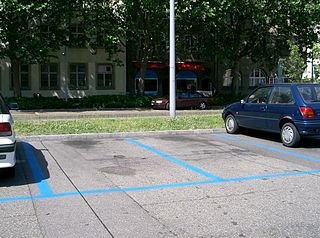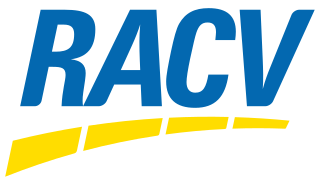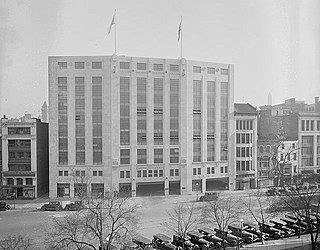
Campsite, campground, and camping pitch are all related terms regarding a place used for camping. The usage differs between British English (UK) and American English (US).

Parking is the act of stopping and disengaging a vehicle and leaving it unoccupied. Parking on one or both sides of a road is often permitted, though sometimes with restrictions. Some buildings have parking facilities for use of the buildings' users. Countries and local governments have rules for design and use of parking spaces.

Since the start of the twentieth century, the role of cars has become highly important, though controversial. They are used throughout the world and have become the most popular mode of transport in many of the more developed countries. In developing countries, the effects of the car on society are not as visible, however they are nonetheless significant. The development of the car built upon the transport sector first started by railways. This has introduced sweeping changes in employment patterns, social interactions, infrastructure and the distribution of goods.

A park and ride, also known as incentive parking or a commuter lot, is a parking lot with public transport connections that allows commuters and other people heading to city centres to leave their vehicles and transfer to a bus, rail system, or carpool for the remainder of the journey. The vehicle is left in the parking lot during the day and retrieved when the owner returns. Park and rides are generally located in the suburbs of metropolitan areas or on the outer edges of large cities. A park and ride that only offers parking for meeting a carpool and not connections to public transport may also be called a park and pool.

The car-free movement is a broad, informal, emergent network of individuals and organizations, including social activists, urban planners, transportation engineers, environmentalists and others, brought together by a shared belief that large and/or high-speed motorized vehicles are too dominant in most modern cities. The goal of the movement is to create places where motorized vehicle use is greatly reduced or eliminated, by converting road and parking space to other public uses and rebuilding compact urban environments where most destinations are within easy reach by other means, including walking, cycling, public transport, personal transporters, and mobility as a service.

A parking space, parking place or parking spot is a location that is designated for parking, either paved or unpaved. It can be in a parking garage, in a parking lot or on a city street. The space may be delineated by road surface markings. The automobile fits inside the space, either by parallel parking, perpendicular parking or angled parking.

The Royal Automobile Club of Victoria (RACV) is a motoring club and mutual organisation. It offers various services to members, including insurance and roadside assistance.

A truck stop, known as a service station in the United Kingdom, and a travel center by major chains in the United States, is a commercial facility which provides refueling, rest (parking), and often ready-made food and other services to motorists and truck drivers. Truck stops are usually located on or near a busy road.

A recreational vehicle park or caravan park is a place where people with recreational vehicles can stay overnight, or longer, in allotted spaces known as "sites" or "campsites". They are also referred to as campgrounds, though a true campground also provides facilities for tent camping; many facilities calling themselves "RV parks" also offer tent camping or cabins with limited facilities.

A multistorey car park or parking garage, also called a multistory, parking building, parking structure, parkade, parking ramp, parking deck or indoor parking, is a building designed for car, motorcycle and bicycle parking and where there are a number of floors or levels on which parking takes place. It is essentially an indoor, stacked car park. The first known multistory facility was built in London in 1901, and the first underground parking was built in Barcelona in 1904. The term multistory is almost never used in the US, since parking structures are almost all multiple levels. Parking structures may be heated if they are enclosed.

Intermodal passenger transport, also called mixed-mode commuting, involves using two or more modes of transportation in a journey. Mixed-mode commuting is often used to combine the strengths of various transportation options. A major goal of modern intermodal passenger transport is to reduce dependence on the automobile as the major mode of ground transportation and increase use of public transport. To assist the traveller, various intermodal journey planners such as Rome2rio and Google Transit have been devised to help travellers plan and schedule their journey.
Fractional ownership is a method in which several unrelated parties can share in, and mitigate the risk of, ownership of a high-value tangible asset, usually a jet, yacht or piece of resort real estate. It can be done for strictly monetary reasons, but typically there is some amount of personal access involved. One of the main motivators for a fractional purchase is the ability to share the costs of maintaining an asset that will not be used full-time by one owner.

A condo hotel, also known as a condotel, hotel condo, or a contel, is a building that is legally a condominium but operated as a hotel, offering short-term rentals, and which maintains a front desk.

Motor vehicle registration is the registration of a motor vehicle with a government authority, either compulsory or otherwise. The purpose of motor vehicle registration is to establish a link between a vehicle and an owner or user of the vehicle. This link might be used for taxation or crime detection purposes. While almost all motor vehicles are uniquely identified by a vehicle identification number, only registered vehicles display a vehicle registration plate and carry a vehicle registration certificate. Motor vehicle registration is different from motor vehicle licensing and roadworthiness certification.
A car rental, hire car or car hire agency is a company that rents automobiles for short periods of time to the public, generally ranging from a few hours to a few weeks. It is often organized with numerous local branches, and primarily located near airports or busy city areas and often complemented by a website allowing online reservations.

Towing is coupling two or more objects together so that they may be pulled by a designated power source or sources. The towing source may be a motorized land vehicle, vessel, animal, or human, and the load being anything that can be pulled. These may be joined by a chain, rope, bar, hitch, three-point, fifth wheel, coupling, drawbar, integrated platform, or other means of keeping the objects together while in motion.

Internavi is a vehicle telematics service offered by the Honda Motor Company to drivers in Japan. In the United States, the service is known as HondaLink, or sometimes MyLink. It provides mobile connectivity for on-demand traffic information services and internet provided maps displayed inside selected Honda vehicles. The service began August 1997 and was first offered in the 1998 Honda Accord and the Honda Torneo sold only in Japan starting July 1998. The service received a revision to services offered October 2002, adding traffic information delivery capabilities for subscribers to the Internavi Premium Club, and was optional on most Honda vehicles sold in Japan. VICS was integrated into the service starting September 2003. Membership in the service has steadily grown to exceed 5 million subscribers as of March 2007.
The retail format influences the consumer's store choice and addresses the consumer's expectations. At its most basic level, a retail format is a simple marketplace, that is; a location where goods and services are exchanged. In some parts of the world, the retail sector is still dominated by small family-run stores, but large retail chains are increasingly dominating the sector, because they can exert considerable buying power and pass on the savings in the form of lower prices. Many of these large retail chains also produce their own private labels which compete alongside manufacturer brands. Considerable consolidation of retail stores has changed the retail landscape, transferring power away from wholesalers and into the hands of the large retail chains.

The Capital Garage was a ten-story parking garage that once stood at 1320 New York Avenue NW in downtown Washington, D.C. It was built for the Shannon & Luchs real estate firm and designed by local architect Arthur B. Heaton, whose landmark buildings in the city include Riggs National Bank, Stockton Hall, and the Churchill Hotel. The building was designed in the Streamline Moderne architectural style with Gothic Revival features. Ornamental details on its façade included bas-reliefs of automobiles and headlights as well as lion-headed grotesques. In addition to providing parking spaces, the Capital Garage also included a gas station, carwash, repair shop, and retail space.














